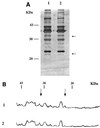Characterization of a nosocomial outbreak caused by a multiresistant Acinetobacter baumannii strain with a carbapenem-hydrolyzing enzyme: high-level carbapenem resistance in A. baumannii is not due solely to the presence of beta-lactamases
- PMID: 10970374
- PMCID: PMC87377
- DOI: 10.1128/JCM.38.9.3299-3305.2000
Characterization of a nosocomial outbreak caused by a multiresistant Acinetobacter baumannii strain with a carbapenem-hydrolyzing enzyme: high-level carbapenem resistance in A. baumannii is not due solely to the presence of beta-lactamases
Abstract
From February to November 1997, 29 inpatients at Ramón y Cajal Hospital, Madrid, Spain, were determined to be either colonized or infected with imipenem- and meropenem-resistant Acinetobacter baumannii (IMRAB) strains (MICs, 128 to 256 microg/ml). A wide antibiotic multiresistance profile was observed with IMRAB strains. For typing IMRAB isolates, pulsed-field gel electrophoresis was used. For comparative purposes, 30 imipenem- and meropenem-susceptible A. baumannii (IMSAB) strains isolated before, during, and after the outbreak were included in this study. The molecular-typing results showed that the outbreak was caused by a single IMRAB strain (genotype A). By cloning experiments we identified a class D beta-lactamase (OXA-24) encoded in the chromosomal DNA of this IMRAB strain which showed carbapenem hydrolysis. Moreover, the outer membrane profile of the IMRAB strain showed a reduction in the expression of two porins at 22 and 33 kDa when compared with genetically related IMSAB isolates. In addition no efflux mechanisms were identified in the IMRAB strains. In summary, we report here the molecular characterization of a nosocomial outbreak caused by one multiresistant A. baumannii epidemic strain that harbors a carbapenem-hydrolyzing enzyme. Although alterations in the penicillin-binding proteins cannot be ruled out, the reduction in the expression of two porins and the presence of this OXA-derived beta-lactamase are involved in the carbapenem resistance of the epidemic nosocomial IMRAB strain.
Figures




References
-
- Afzal M S, Livermore D. Worldwide emergence of carbapemem-resistant Acinetobacter spp. J Antimicrob Chemother. 1998;41:576–577. - PubMed
-
- Amyes S G B, Young H-K. Mechanism of antibiotic resistance in Acinetobacter spp.—genetics of resistance. In: Bergogne-Berezin E, Joly-Guillou M L, Towner K J, editors. Acinetobacter: microbiology, epidemiology, infections, management, 1996. New York, N.Y: CRC Press; 1996. pp. 185–223.
-
- Bergogne-Bérézin E. Resistance of Acinetobacter spp. to antimicrobials—overview of clinical resistance patterns and therapeutic problems. In: Bergogne-Berezin E, Joly-Guillou M L, Towner K J, editors. Acinetobacter: microbiology, epidemiology, infections, management, 1996. New York, N.Y: CRC Press; 1996. pp. 133–183.
-
- Bergogne-Bérézin E, Joly-Guillou M L, Vieu J F. Epidemiology of nosocomial infections due to Acinetobacter calcoaceticus. J Hosp Infect. 1987;10:105–113. - PubMed
MeSH terms
Substances
LinkOut - more resources
Full Text Sources
Molecular Biology Databases

